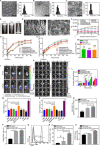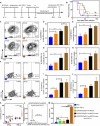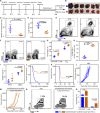A tumor-to-lymph procedure navigated versatile gel system for combinatorial therapy against tumor recurrence and metastasis
- PMID: 32917616
- PMCID: PMC7473750
- DOI: 10.1126/sciadv.abb3116
A tumor-to-lymph procedure navigated versatile gel system for combinatorial therapy against tumor recurrence and metastasis
Abstract
Application of cancer vaccines is limited due to their systemic immunotoxicity and inability to satisfy all the steps, including loading of tumor antigens, draining of antigens to lymph nodes (LNs), internalization of antigens by dendritic cells (DCs), DC maturation, and cross-presentation of antigens for T cell activation. Here, we present a combinatorial therapy, based on a α-cyclodextrin (CD)-based gel system, DOX/ICG/CpG-P-ss-M/CD, fabricated by encapsulating doxorubicin (DOX) and the photothermal agent indocyanine green (ICG). Upon irradiation, the gel system exhibited heat-responsive release of DOX and vaccine-like nanoparticles, CpG-P-ss-M, along with chemotherapy- and phototherapy-generated abundant tumor-specific antigen storage in situ. The released CpG-P-ss-M acted as a carrier adsorbed and delivered antigens to LNs, promoting the uptake of antigens by DCs and DC maturation. Notably, combined with PD-L1 blocking, the therapy effectively inhibited primary tumor growth and induced tumor-specific immune response against tumor recurrence and metastasis.
Copyright © 2020 The Authors, some rights reserved; exclusive licensee American Association for the Advancement of Science. No claim to original U.S. Government Works. Distributed under a Creative Commons Attribution NonCommercial License 4.0 (CC BY-NC).
Figures






Similar articles
-
I n situ tumor vaccine with optimized nanoadjuvants and lymph node targeting capacity to treat ovarian cancer and metastases.Acta Pharm Sin B. 2024 Sep;14(9):4102-4117. doi: 10.1016/j.apsb.2024.06.003. Epub 2024 Jun 8. Acta Pharm Sin B. 2024. PMID: 39309485 Free PMC article.
-
In Situ Tumor Vaccine for Lymph Nodes Delivery and Cancer Therapy Based on Small Size Nanoadjuvant.Small. 2023 Aug;19(33):e2301041. doi: 10.1002/smll.202301041. Epub 2023 Apr 20. Small. 2023. PMID: 37078903
-
Bubble-generating polymersomes loaded with both indocyanine green and doxorubicin for effective chemotherapy combined with photothermal therapy.Acta Biomater. 2018 Jul 15;75:386-397. doi: 10.1016/j.actbio.2018.05.033. Epub 2018 May 21. Acta Biomater. 2018. PMID: 29793073
-
Dendritic cell gene therapy.Surg Oncol Clin N Am. 2002 Jul;11(3):645-60. doi: 10.1016/s1055-3207(02)00027-3. Surg Oncol Clin N Am. 2002. PMID: 12487060 Review.
-
Dendritic cells based immunotherapy.Am J Cancer Res. 2017 Oct 1;7(10):2091-2102. eCollection 2017. Am J Cancer Res. 2017. PMID: 29119057 Free PMC article. Review.
Cited by
-
Drug-loaded microbubble delivery system to enhance PD-L1 blockade immunotherapy with remodeling immune microenvironment.Biomater Res. 2023 Feb 9;27(1):9. doi: 10.1186/s40824-023-00350-5. Biomater Res. 2023. PMID: 36759928 Free PMC article.
-
An amphiphilic dendrimer as a light-activable immunological adjuvant for in situ cancer vaccination.Nat Commun. 2021 Aug 16;12(1):4964. doi: 10.1038/s41467-021-25197-z. Nat Commun. 2021. PMID: 34400628 Free PMC article.
-
Hydrogel-guided strategies to stimulate an effective immune response for vaccine-based cancer immunotherapy.Sci Adv. 2022 Nov 25;8(47):eadc8738. doi: 10.1126/sciadv.adc8738. Epub 2022 Nov 25. Sci Adv. 2022. PMID: 36427310 Free PMC article. Review.
-
Bacterial outer membrane vesicle based versatile nanosystem boosts the efferocytosis blockade triggered tumor-specific immunity.Nat Commun. 2023 Mar 25;14(1):1675. doi: 10.1038/s41467-023-37369-0. Nat Commun. 2023. PMID: 36966130 Free PMC article.
-
Subcellular Organelle Targeting as a Novel Approach to Combat Tumor Metastasis.Pharmaceutics. 2025 Feb 5;17(2):198. doi: 10.3390/pharmaceutics17020198. Pharmaceutics. 2025. PMID: 40006565 Free PMC article. Review.
References
-
- Schroeder A., Heller D. A., Winslow M. M., Dahlman J. E., Pratt G. W., Langer R., Jacks T., Anderson D. G., Treating metastatic cancer with nanotechnology. Nat. Rev. Cancer 12, 39–50 (2011). - PubMed
-
- Fidler I. J., Tumor heterogeneity and the biology of cancer invasion and metastasis. Cancer Res. 38, 2651–2660 (1978). - PubMed
-
- Suzuki H., Freije D., Nusskern D. R., Okami K., Cairns P., Sidransky D., Isaacs W. B., Bova G. S., Interfocal heterogeneity of PTEN/MMAC1 gene alterations in multiple metastatic prostate cancer tissues. Cancer Res. 58, 204–209 (1998). - PubMed
-
- Coley H. M., Mechanisms and strategies to overcome chemotherapy resistance in metastatic breast cancer. Cancer Treat. Rev. 34, 378–390 (2008). - PubMed
Publication types
LinkOut - more resources
Full Text Sources
Other Literature Sources
Research Materials

